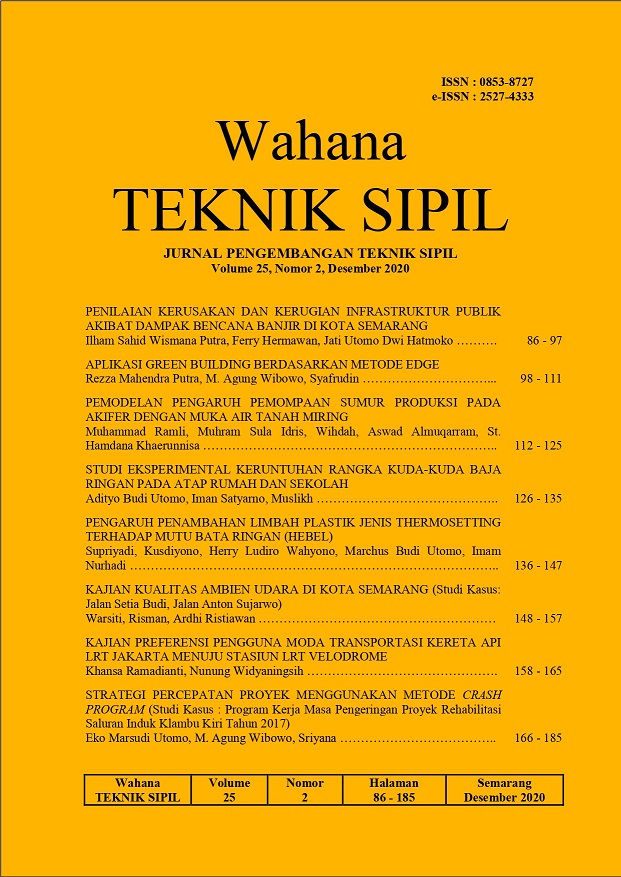PENILAIAN KERUSAKAN DAN KERUGIAN INFRASTRUKTUR PUBLIK AKIBAT DAMPAK BENCANA BANJIR DI KOTA SEMARANG
DOI:
https://doi.org/10.32497/wahanats.v25i2.2154Keywords:
value engineering, infrastructure, flood, disasterAbstract
Flood is a disaster that has the biggest threat, in terms of the number of victims or losses. Semarang City is a city that is classified as a flood prone area, this is due to the geographical location in the lowlands and highlands. The impact of the flood disaster caused damage and losses from various sectors of public infrastructure including the education service sector and health services. Damage and loss of public infrastructure will burden the government in the post-flood recovery phase. An assessment of infrastructure damage and losses from flooding is needed in order to help the Semarang City Government prepare a budget plan and manage rehabilitation and reconstruction. The purpose of this research is to explore the loss of public infrastructure due to the impact of the flood disaster, so that it can accelerate the post-disaster recovery process and management strategies for the risk of further flood disasters. The valuation method used is ECLAC (Economic Commission for Latin American and the Caribbean) Method. This method can identify damage and estimate the losses caused by floods. The results of this study are that each public infrastructure building has a different level of damage and loss and the budget allocation for disaster management each year is still inadequate. A risk transfer strategy is needed with an insurance financing scheme based on the level of risk in each infrastructure building.References
Adhitya Wardhono, & Rondhi, M. (2010). Perhitungan Kerusakan dan Kerugian dalam Perspektif Ekonomi dan Sosial dengan Metode ECLAC pada Bencana Banjir Bandang Panti, Kabupaten Jember-Jawa Timur. https://doi.org/10.13140/RG.2.1.3346.9840
Benali, N., & Feki, R. (2017). The impact of natural disasters on insurers”™ profitability: Evidence from Property/Casualty Insurance company in United States. Research in International Business and Finance, 42, 1394”“1400. https://doi.org/10.1016/j.ribaf.2017.07.078
Bennett, D. L. (2018). Infrastructure investments and entrepreneurial dynamism in the U.S. Journal of Business Venturing. https://doi.org/10.1016/j.jbusvent.2018.10.005
Buchori, I., Sugiri, A., Mussadun, M., Wadley, D., Liu, Y., Pramitasari, A., & Pamungkas, I. T. D. (2018). A predictive model to assess spatial planning in addressing hydro-meteorological hazards: A case study of Semarang City, Indonesia. International Journal of Disaster Risk Reduction, 27, 415”“426. https://doi.org/10.1016/j.ijdrr.2017.11.003
Cass, N., Schwanen, T., & Shove, E. (2018). Infrastructures, intersections and societal transformations. Technological Forecasting and Social Change, 137, 160”“167. https://doi.org/10.1016/j.techfore.2018.07.039
Diakakis, M., Andreadakis, E., Nikolopoulos, E. I., Spyrou, N. I., Gogou, M. E., Deligiannakis, G., Katsetsiadou, N. K., Antoniadis, Z., Melaki, M., Georgakopoulos, A., Tsaprouni, K., Kalogiros, J., & Lekkas, E. (2019). An integrated approach of ground and aerial observations in flash flood disaster investigations. The case of the 2017 Mandra flash flood in Greece. International Journal of Disaster Risk Reduction, 33, 290”“309. https://doi.org/10.1016/j.ijdrr.2018.10.015
Havko, J., Titko, M., & KováÄová, J. (2017). Vulnerability of the City Infrastructure as a Part of the Resilient City Concept. Procedia Engineering, 192, 307”“312. https://doi.org/10.1016/j.proeng.2017.06.053
Madjid, N. C. (2018). ANALISIS METODE PENGHITUNGAN DAN ALOKASI ANGGARAN BENCANA ALAM. Simposium Nasional Keuangan Negara, 1046”“1065.
Mol, J. M., Botzen, W. J. W., & Blasch, J. E. (2018). Behavioral motivations for self-insurance under different disaster risk insurance schemes. Journal of Economic Behavior & Organization. https://doi.org/10.1016/j.jebo.2018.12.007
Osti, R., Hishinuma, S., Miyake, K., & Inomata, H. (2011). Lessons learned from statistical comparison of flood impact factors among southern and eastern Asian countries: Statistical comparison of flood impact factors among Asian countries. Journal of Flood Risk Management, 4(3), 203”“215. https://doi.org/10.1111/j.1753-318X.2011.01107.x
Saidi, S., Kattan, L., Jayasinghe, P., Hettiaratchi, P., & Taron, J. (2018). Integrated infrastructure systems””A review. Sustainable Cities and Society, 36, 1”“11. https://doi.org/10.1016/j.scs.2017.09.022
Severen, C., & Plantinga, A. J. (2018). Land-use regulations, property values, and rents: Decomposing the effects of the California Coastal Act. Journal of Urban Economics, 107, 65”“78.
https://doi.org/10.1016/j.jue.2018.07.001
Yilema, M. G., & Gianoli, A. (2018). Infrastructure governance: Causes for the poor sectoral coordination among infrastructure sectors of Addis Ababa. Cities, 83, 165”“172. https://doi.org/10.1016/j.cities.2018.06.019
Downloads
Published
Issue
Section
License
Authors who publish with this journal agree to the following terms:Authors retain copyright and grant the journal right of first publication with the work simultaneously licensed under a Creative Commons Attribution License that allows others to share the work with an acknowledgement of the work's authorship and initial publication in this journal.
Authors are able to enter into separate, additional contractual arrangements for the non-exclusive distribution of the journal's published version of the work (e.g., post it to an institutional repository or publish it in a book), with an acknowledgement of its initial publication in this journal.
Authors are permitted and encouraged to post their work online (e.g., in institutional repositories or on their website) prior to and during the submission process, as it can lead to productive exchanges, as well as earlier and greater citation of published work (See The Effect of Open Access).






